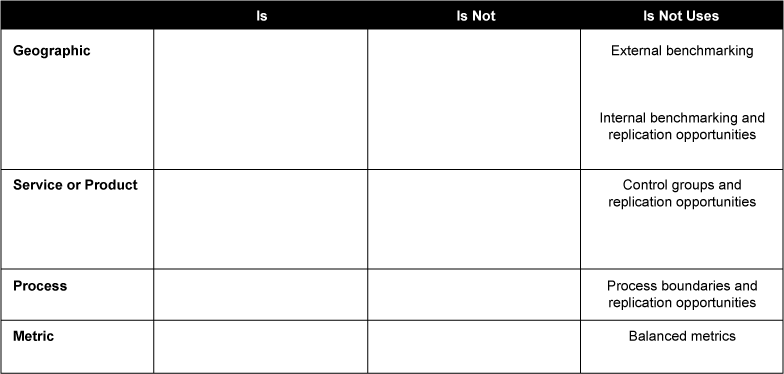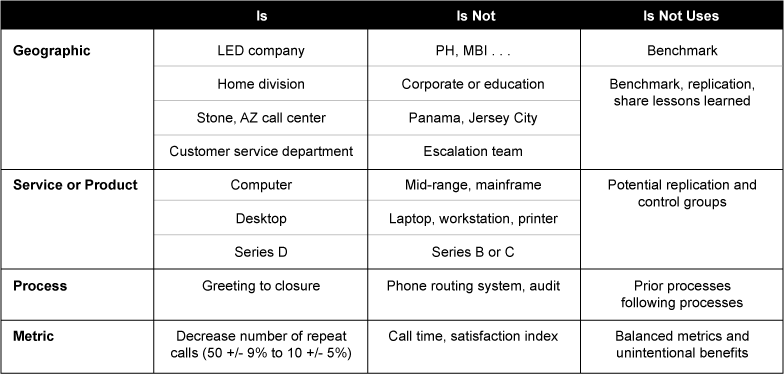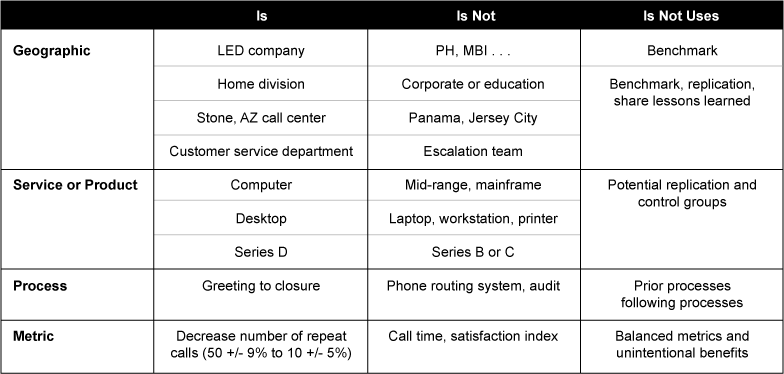
With a structure to identify geography, service or product, process and the main project metric, the “is/is-not analysis” can be one of the most useful tools to sharpen the definition and scope of a Six Sigma project (see Table 1). It also has benefits for other DMAIC (Define, Measure, Analyze, Improve, Control) phases.
Specifically, the is/is-not analysis:
- Creates a geographically searchable project problem statement
- Describes what the project will and will not address
- Identifies internal and external benchmarking opportunities
- Identifies potential control groups for “better” research methods
- Identifies project replication opportunities
- Identifies balanced metrics
- Protects against scope creep
- Differentiates between core and extended team
- Maintains team focus throughout all phases of DMAIC
- Provides direction from/to external stakeholders

The column headed Is Not Uses reminds the project team of the benefits and uses of this analysis.
The is/is-not analysis should be completed during or immediately after project selection. This analysis validates the project and creates a specific project problem statement. Think of the analysis as a view from space that quickly zooms directly down to the continent, country, city, street and finally to the individual person walking the street. The parallel is to zoom from the company, division, plant, product, process and metric to ensure that the project is scoped correctly and is searchable.
Geographic
To begin, identify the company in the first row of the Is column. Then list the company’s competitors in the corresponding Is Not column. As shown in the Is Not Uses column, these competitors represent potential external benchmarking opportunities. In the Is column of the second row, if appropriate, list the division or country. Place other divisions or countries in the Is Not portion. These represent potential internal benchmarking opportunities for analysis and potential replication opportunities. Continue zooming in geographically until the specific plant, city or department that the project applies to is reached. Do not allow team members to default to “others” as an answer to the Is Not side of the analysis. They will regret this lack of rigor in the Analyze phase.
The tables below illustrate a service or transactional example and a production or manufacturing example.


Service or Product
In the first row of the service or product section, enter the service category or product family. In the subsequent rows narrow the focus until a specific service or product is identified. This activity represents a significant opportunity to reduce scope. However, often there is reluctance to do this because of prior direction (large scope) or a directive to achieve a certain amount of dollar savings.
There are several ways to address these issues. If the project has been mandated with a large scope, then a conversation with the sponsor and other stakeholders may be in order to explain how replication or multi-generational projects can help achieve the mandatory dollar savings. Another approach is to present the need to conduct good research using control groups to more appropriately identify or validate project improvements which offer dollar savings. If the project team is tackling its first project then the case for not overwhelming the team must be made. The team is learning a new methodology (DMAIC), new tools (and methods) and new team dynamics.
Often, these explanations for reduced scope are sufficient to ease concerns and simultaneously to exceed dollar goals. It helps that most teams consistently undervalue the potential savings of their projects by two or three times the final achieved savings (i.e., additional benefits discovered, quick improvements, unexpected replication opportunities).
Process
This section includes as many rows as needed to drill down from the high-level process to the appropriate sub-process to be improved. At the very least, this section should identify the first and last steps of that sub-process. To clearly differentiate what is not within the project’s scope, the Is Not portion should identify the steps that immediately precede and follow the steps to be addressed. This naturally creates a boundary from which core and extended team members can be identified. Prior processes can be thought of as suppliers of raw materials, data and information, human resources and finances. The after process steps indicate potential extended team members for both internal and external customers.
Metric
This section should only include the main project metric. A baseline and goal should be included. Often, a challenge at this point is to identify the amount of variation present and the goal for reducing it. The Is Not side includes potentially balanced metrics that are invaluable during the Control phase and should be further defined and documented in the Measure phase with a rigorous data management plan.
Better Project Problem Statement, Increased Success
A searchable problem statement is revealed by looking at the Is side of the finished analysis from the bottom-up. Start at the bottom of the Is side and work up through metric, process, product and geography. For the production or manufacturing example, the result is:
“Increase rolled throughput yield from 70 to 90 percent for the oven-to-inspection process steps of Line 4 for the 80-pound carriage gears manufactured in the heat treat department at the Newark, Ohio, plant of the Auto Division of TELZO Company.”
Training and facilitating this method in class with teams and/or project leaders requires only a short explanation, usually provided while they are filling in the form on flip chart paper with big markers so all can see and share. Alternatively, this analysis can be completed as part of the project selection process to gain clarity around a potential project. The is/is-not analysis is a wonderful way to narrow the scope of projects, increase chances for success, accelerate projects and realize benefits sooner.